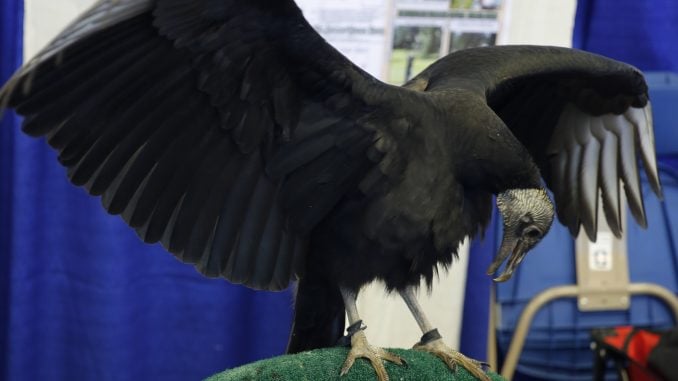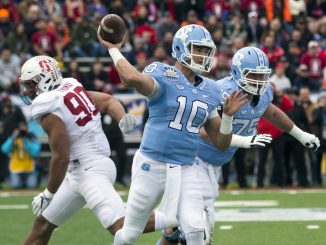
RALEIGH — After quietly surveying the scene at March’s Dixie Deer Classic for several minutes, Snoopy decided it was time to dance.
The black vulture was sitting on a large metal perch in the shape of a hoop, one foot chained securely to the base to keep him from flying around in search of carrion, while visitors to the Classic admired him.
Slowly, Snoopy began to walk in place, taking comically large, careful steps, as if walking through heavy snow. Not satisfied with the amount of attention he was drawing to himself, Snoopy gracefully unfurled his wings to their full 3-foot span.
“It’s his vulture dance,” said a volunteer from the American Wildlife Refuge who was manning the Birds of Prey booth at the Deer Classic. “Oh, he’s really doing it, too!”
Continuing to high-step, Snoopy slowly turned 180 degrees, until all that was visible from behind his outstretched wings was his rapidly bobbing head.
Was this dance part of some type of vulture mating display, or perhaps a defense mechanism when surrounded by humans who could be interpreted as predators?
“No,” the volunteer replied. “He’s just trying to hide the fact that he’s working to take off that ankle chain.”
Sure enough, a quick peek around the shield thrown up by Snoopy’s wings revealed that the bird was working hard with his beak, in an effort to pry away the metal ring around one foot.
Breathtaking majesty, coupled with diabolical cleverness — but that’s just life at the American Wildlife Refuge, the largest raptor-only volunteer-run center in the Triangle area.
Snoopy’s dance is the perfect embodiment of the Refuge’s educational programs, which, as one video declares, “teach people the true face of nature and show how harsh and beautiful it can be.”
Nearby, easy to miss among the wild, feather-flying display of the vulture, is a much smaller, calmer bird. Standing just six inches tall, in a puff of feathers, is Princess.

Despite her size and stuffed-animal appearance, make no mistake. Princess is a bad, bad bird, even as she innocently stands perched on one foot atop a stuffed cushioned stool.
“She doesn’t like the metal perches,” a volunteer explains. “Falcons like flat better.”
Princess is an American kestrel.
“She’s also known as a sparrow hawk,” says the volunteer, “even though she’s really in the falcon family, they call her a sparrow hawk.”
And the reason for that?
“She can take a sparrow right out of the sky,” the volunteer says. “She’s very fast. They live fast — that’s the best way to explain it. Our heart beats 82 to 90 beats per minute. Hers is 500.”
Kestrels live in North Carolina in large numbers.
“You see them on the wires when you’re driving, especially down east, in the country,” the volunteer says. “On the telephone wires. A lot of times, they’re sitting by themselves. The way you can tell it’s a kestrel is usually their tail or head are bobbing. You can see that in their silhouette while driving. When you see that bob — oh, that’s a kestrel.”
The bobbing is the kestrel’s way of scanning for prey. In addition to sound and smell, the birds can see ultraviolet light, which allows it to hone in on ground prey. The kestrel’s diet combines small birds — a favorite of larger falcons — and small mammals like voles and squirrels — similar to a hawk.
Unlike larger birds of prey, kestrels can also hover in place, waiting for a potential victim to make a wrong move, before striking with crippling speed.
Snoopy and Princess, like most of the birds the Refuge brings to schools, libraries and public events like the Dixie Deer Classic, is a permanent resident, unable to be rehabilitated and released into the wild.
Last year, the Wildlife Refuge has 235 raptors in its care, most of them permanent residents. At the same time, their goal is to rehabilitate and release injured birds. A total of 159 birds were released back into the wild last year, including hawks, herons, eagles and owls. Since 2001, the American Wildlife Refuge has rehabilitated more than 2,100 birds, at a 71 percent survival rate — which is higher than that of much larger, better-funded centers.
The Refuge, based in Raleigh, operates on a shoestring budget, often making due on less than $20,000 a year. All the workers are volunteers, and the land on which the center is located is donated free-of-charge by a private owner. Still, the organization is able to staff a four-room hospital and 24 outdoor cages, each customized to a different type of raptor, with volunteers and licensed professionals donating their time.
The Refuge also holds hundreds of educational events each year, where Snoopy and Princess get to demonstrate the fearsome beauty of the avian world, up close and personal.
“A lot of the education is actually uneducating people about what they think they know,” says the volunteer, as Snoopy continues to dance, while trying to break himself free.



